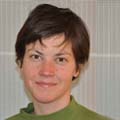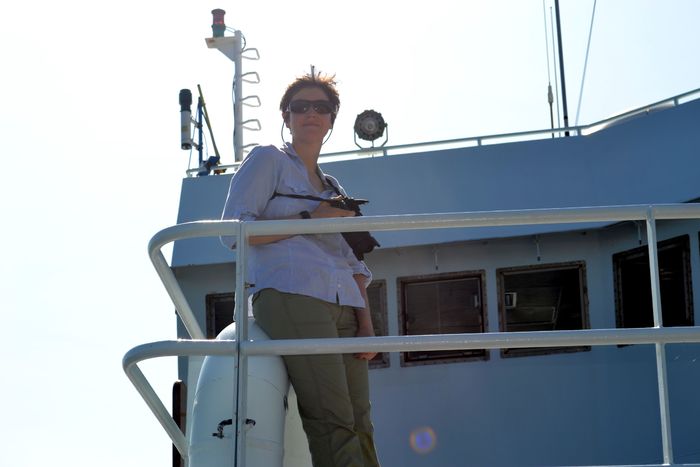Monday July 15th, 2013
Student’s primary responsibilities on this expedition are to design and complete a project while we’re on the ship and to cover a daily 4 hour watch in the control room where the pilots and navigator operate ROPOS. Watch duties include entering notes and observations about the dive into a software program that is synchronized with the navigation system and the cameras on ROPOS. Every dive is recorded on an HD camera. The loggers watch and take notes on the dive, appending each observation to a series with the location, time and a photo of the observation. Logged entries include basic operations like when ROPOS lands on the seafloor, when we accomplish a dive task such as plugging an instrument into the power supply, or noting features of the seafloor terrain when we’re conducting a cable survey route.
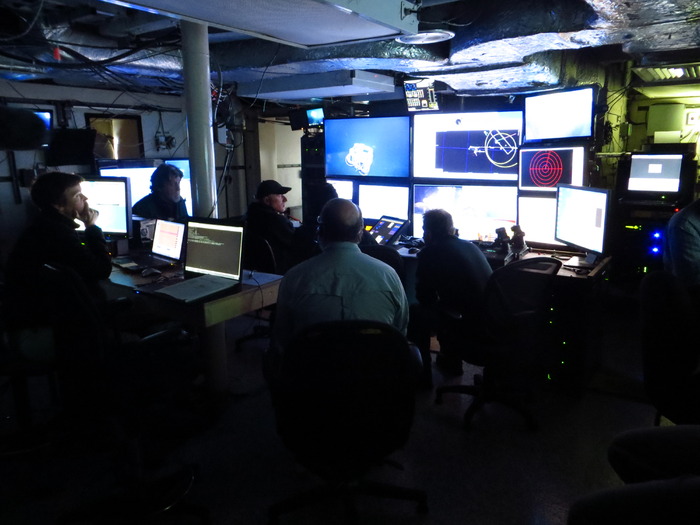
My project is a short video documentary showing the dive operations from the control room where ROPOS is operated. This theme evolved out of an initial interest in portraying the various people involved in this expedition. After a few interviews, I realized that project was too large for a short film, so instead I focused on the backbone of this expedition: dive operations. The documentary process involved conducting video interviews, selecting dive footage of the geology and construction operations, and hours and hours of cutting and editing. It’s nearly complete and will soon be available for viewing on the website.

Those responsibilities have provided a structure to my time here one board, but it’s the peripheral things that add richness to the experience – learning about the lives of the ship’s crew on board, watching Owen and Danny fish for salps over the side of the ship with a big white bucket, seeing Dana preserve sea water from a 2600m CTD cast, then boil off the liquid to capture the salt, ‘full of whale poop and excellent for cooking!’, she says.

The ship’s crew is comprised of engineers, marine technicians, oilers, cooks, and the Captain. Each time ROPOS or the CTD goes in the water, the marine technicians assist on deck, so we work with them quite a bit. They are, hands down, among the nicest people I have ever worked with. I suspect sea life has a way of cultivating qualities, or naturally selecting people who are well suited to live and work together in a confined space. You won’t fare happily on a ship if you’re easily riled or thin skinned. Ship life rewards those who are friendly but not intruding, patient and forgiving. Captain Russ told a story from another ship of a hot-tempered captain who got angry when his crew asked the same question more than once. In a storm, the first mate was too fearful to ask for clarification about a maneuver he didn’t understand, and turned this ship the wrong way into a storm. Virtues aside, patience has pragmatic value out here.
Saturday July 13th, 2013
During breakfast this morning Dana, one of the ship technicians, walked past the galley and said ‘There’s a mola-mola off starboard’. I hadn’t a clue what that was but Danny Grünbaum, a biological oceanographer sitting next to me hopped up and headed toward the deck. I followed, trusting that if he was letting his breakfast go cold to see it, it was worth a look.
From the deck I spotted them amidst the several albatross that have been following the ship, eating the food we release form the scullery. Apparently these fish can grow to be many feet in length. They feed on gelatinous critters (jellyfish, salp, nematodes, etc), and Danny recalled that when feeding, they swim vertically, catching food as they ascend. Their bodies were shaped like very flat, very large, grey spearheads. They had long, wide dorsal and ventral fins, though at the sea surface they lay nearly horizontal on their sides, awkwardly flapping dorsal fins in the air as the ventral fins slowly propelled them forward. They seemed to be following the boat, but when the birds moved further out we saw the fish follow them, and realized they were chasing after the birds. I had misjudged their intelligence; they come to the surface and lie on their sides near the albatross, flashing these parasitic copepods within eyesight of the birds. After a while, the birds recognized the protrusions on the fish as food, and pecked them neatly off the sides of the relieved mola-molas.
Friday July 12th, 2013
11am
On this cruise people work around the clock. Every one of the dive operations has gone late into the night or carried over late into the next day. The ROPOS team is on a 12hr on, 12 hr off schedule. The ship’s crew is on a 4hr on, 8 hr off schedule, plus overtime. The scientists are on a 24 hr shift, and sleep when opportunities arise. There are few things that provide rhythm and routine to our days, and most people aren't sure what day it is, let alone how many days they've been on ship without looking at a calendar. Fortunately this continuous stream of ship time is punctuated by meals and laundry days. Every day breakfast is served at 7:15 am, lunch is served at 11:30 am, and dinner, at 5 pm. Since there are three washing machines for about 50 people, laundry days are scheduled to prevent bottlenecks. So each group of cabins has a weekly laundry day, and today I got to clean my clothes, bedding, and towels. It’s refreshing to do something familiar and mundane so far from land.
***
8:45pm
The Inuit have more than 23 names for snow. We need that many, or more, to characterize all the distinct, transient patterns that appear
on the sea surface. Earlier the sea was smooth, deeply blue, almost glossy, and undulating with swells. Now the winds have picked up gently, and the surface is marked by plaid-like wind-stripes with iridescent rays of low-angle light as the sun falls into the horizon.
I’m sitting on the third deck now, chilled by the wind and reflecting on the decades of work that Deb Kelley and John Delaney, as well as other scientists, engineers, policy-makers, and students, have put into realizing a dream of cabling instruments to the seafloor at the edge of a tectonic plate that is slowly subducting towards the Earth’s core. This evening, for the first time, information streamed from the seafloor, into the sensors, through the RSN cables, and into our grasp. This was a preliminary test, but it’ working.
But there’s something this project can’t achieve by streaming novel information to our computers on land. Deb said it just a few minutes
ago, standing here on the top deck watching the sun set into the wide-open ocean. She said, "It’s good for the soul, even on bad
days". The data can’t capture the experience, the direct, unmediated sensation of being at sea, feeling the weather in your gut, and seeing
ocean in all directions without end in sight. The sheer expanse is humbling.
Thursday July 11, 2013
7:41 pm
One of the challenges of a project of this size is the sheer number of contingencies – mechanical, electrical, weather, and contractual- that can bring work at sea to a grinding halt. We have encountered each one of these on the cruise and the scientists, technicians, and crew continuously adjust plans to make the best use of ship time. Expenses for this research vessel plus the ROPOS team and engineers do not come at a insignificant cost. ROV operations can only take place in certain sea states since the swells add significant tension to the cable connecting the sub to the ship. Originally we’d planned to dive at Hydrate Ridge after leaving Newport, but the weather wasn’t permitting, so Deb and John decided to make a 15 hour steam to axial seamount and work there, instead. The goal here at axial is to lay extension cable from the primary to the secondary node, then to power up and test the cable and some of the sensors on the seafloor. We laid the cable last night, but postponed the testing until an electrical problem with ROPOS was resolved. We’re back on the seafloor now. The dive operations will continue all night.
Sunday July 7, 2013
Waters were too rough for the planned dive this morning. We headed back to Newport in the afternoon, to swap out crew and cargo. This is marks the end of leg one. Cecile, one of the project managers gave a talk in the morning to us about working with the fisherman to get permitting for the cable installation. In order lay a cable off the Oregon coast, telecom or otherwise, you must have an agreement with the Oregon Fisherman Cable Committee. This involved having an OFCC representative on the cable survey, traversing the coast to talk with local fisherman and a representative from the OFCC, and making sure that no fishing grounds would be adversely affected by the placement of the cable. One of the node placements was significantly altered, to avoid a fishing location. The concern with the fishing grounds is not so much that the cable will deter the fish, but that the fishing gear may get caught up in the cable line, deterring the fisherman. I questioned this after I learned that fisherman are not allowed to bottom-trawl, there trawling nets are not permitted to scrape along the seafloor. Still, they worried about the cable.
The waves subsided as we slowly pulled into Harbor, and used the opportunity to conduct two more interviews for the short video I’m working on.
One we reached land, most of science party headed to the Rogue Brewery. Later I walked across the bridge along highway 101 through the long stretch of tourist businesses, in search of a grocery store to purchase dark chocolate. Although the Galley has a plentiful supply of junk food available 24/7 (which I have mostly avoided), there was no dark chocolate. Julie Ann made the long trek with me (in reality it was probably not more than 5 miles, but we had to cross the bridge with a very narrow pedestrian walkway and no railing separating us from the cars traveling at 60 mph).
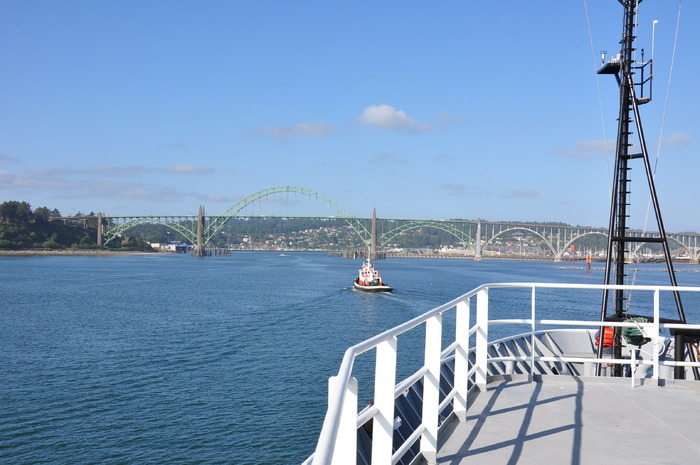
I first learned about gas hydrates in May of 2010. I was in Katie Gulliford’s chemistry course at Tacoma Community College, studying entropy-- the law that the disorder of a system tends to increase- and following the Deepwater Horizon oil spill in the Gulf of Mexico. The New York Times published several stories about the unexpected problems with the attempts to contain the oil gushing out of the seafloor. One such attempt was to lower a 98-ton steel dome with a hole at the top and a pipe connected to the hold, to funnel the leaking oil to a drill ship above. This attempt failed because the oil released methane gas which formed a sludge of methane hydrates – icy material that forms under low temperature and high pressures-- that not only clogged the pipe but also added buoyancy to the dome, threatening to raise it off the seafloor.
Methane hydrates caught my attention in the media again this past spring, in a New York Times piece about commercial extraction of hydrates from offshore deposits in Japan. As the world’s largest importer of natural gas, Japan is interested in supplanting those imports with domestic production of energy from the combustion of methane hydrates.
Outside of the commercial realm, methane hydrates interest to scientists because they sustain diverse microbial communities, contribute to the flux of carbon into the ocean, and may be susceptible to climate change. When methane hydrate is warmed to a gaseous phase, its volume increases by more than a hundredfold. Methane is also about 20 times more potent than carbon dioxide as a greenhouse gas, so if ocean warming increases the dissociation of methane hydrates, the liberated gas could make its way to the atmosphere and further accelerate global warming. In her article in Nature Education (2001), Carolyn Ruppel writes that methane hydrates in the subsea permafrost in the Arctic are indeed liberating methane gas into the atmosphere. The global fraction of methane stores in this region is highly uncertain, but current estimates suggest that less than 0.25% of the global supply of methane is stored in this vulnerable region. The vast majority of methane hydrates, including those in South Hydrate Ridge that OOI will monitor, are a deep enough below the seafloor that even the upper estimates of global warming will not trigger dissociation.
The ocean observatories are placing nodes at Hydrate Ridge not only to study the methane hydrates, but also to, with their suite of broadband seismometers, to improve our capacity to predict earthquakes that occur along the subduction zone. In the event of a large earthquake, even a few minutes of warning could save property and lives.
Saturday July 6th
6:26pm
Steaming out of Newport last night the waves quickly grew stronger…and reacted with my stomach in an unpleasant manner. I went to bed with some Dramamine and was still groggy at 8am this morning. The seas calmed again today, though they’re starting to pick up again now after dinner.
ROPOS took another dive today, first to slowly tour a 10 km route where cable will be laid next summer. The boat steamed ahead at about half a knot while we monitored the terrain from the high definition camera on the sub. Lots of smooth, flat seafloor occasionally spotted with starfish, rattail fish, rockfish, spider crabs, hagfish and other critters I can’t yet name. After surveying the cable route, we visited Einstein’s Grotto, a methane seep on South Hydrate Ridge that looked like a small cave entrance down into Hades lair. It was surrounded by ivory-colored bacterial mats and occasionally burped out bubbles of methane gas. This region has been studied by other scientists; their visits evidenced by markers, a large white bucket, and weights from another submersible. We laid markers at this site, where the mass spectrometer will be placed, and collected two rock samples from the seafloor. I was on a four hour watch for this dive, during which I worked in the control room with the ROPOS operators and entered observations and images from the HD camera into the digital logging system.
Geophysical acoustic imaging shows very strong reflectance in this region, indicating the presence of a free gas zone under the seafloor, possibly 100 meters in length. I asked Skip, a physicist from APL, whether we can infer the volume of gas under the seafloor – that is still highly uncertain, he said. Next year the team will place a seismometer as this location; it will listen for when the methane bubbles shift underneath the seafloor and make micro-cracks in the rock, giving a sense of the plumbing system on Hydrate Ridge. This instrument will also help to determine whether lunar tides affect the flow of gas out of the seep. Deb explained in the live video stream that the spongy upper seafloor may flux under the pressure variations of the tides, modulating the egress of fluids from the seep. Scientists have observed methane bubbles much higher up in the water column than expected; some of the researchers on board are hoping that data from this observatory will shed some light on this conundrum.
In the afternoon we met with the Captain, who regaled us with stories of his colorful past as a rock climber, a crab fisherman, a merchant boat captain and, now, the captain of a research vessel. One of the great pleasures of being on this expedition is working with other adventurous individuals who share an interest in, if not a passion for, the sea.
Friday July 5th, 2013
9:40am
Today we are transiting to Newport to drop of the engineers form L3, the reporter, and the NSF representative who only planned to observe the trouble-shooting dive. We finished the work at Axial Seamount early and will make a quick stop in Newport to let these folks off, then head out to Hydrate Ridge to get an early start on our work there.
Yesterday’s afternoon dive was a science dive – ROPOS, the submersible, ‘flew’ to the International District Hydrothermal Field to view a route where cable will be layed and viewed three incredible black smokers known as El Guapo, Diva, and Escargot. The live video streaming has an excellent voice-over description of the sites from Allison and Dr. Kelley. Black smokers are formed when cold seawater seeps down into fissures in the rocks around active volcanic regions. In its descent, it is heated by the underlying magma. As the water percolates down it loses calcium, magnesium, and other minerals. When this hot, buoyant, and acidic fluid finds a way back up through the rock and to the open ocean, it reacts with the cold, mineral rich seawater and forms the amazing chimneys we visited yesterday.
Today has been a calm day. We had a science meeting in the morning and a project meeting in the afternoon. I conducted an interview with the NSF project manager, and brainstormed making a second documentary with Julie, the chemistry teacher from Aberdeen.
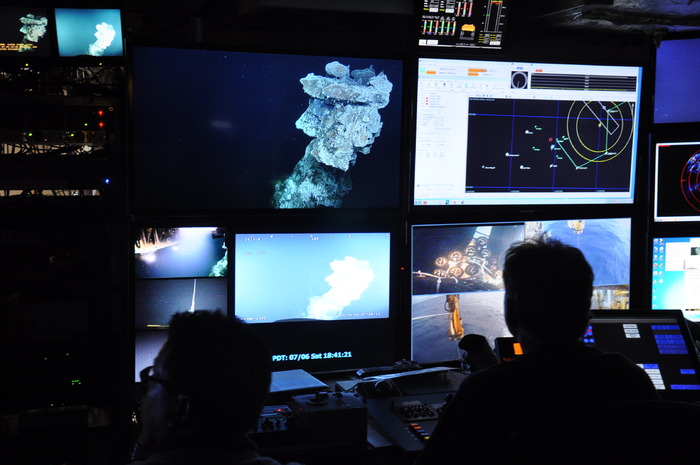
Thursday July 4th 2013
9:50am
I woke this morning to Dr. Deb Kelley saying, ‘Judy, we’re on the seafloor’. The test dives to purge air from the system took all night, and the ROPOS pilots and navigators were just starting the first dive to troubleshoot problems on the node.
The control room was calm when I entered. The Sub had just landed, and was approaching the node. The goal was to unplug the camera from the node, run tests (conducted by technicians at the Pacific City power station) and determine whether an underwater camera connection was the cause of a power leakage. This simple enough task belies a spectacular operation. Doug from L3 Maripro guided the pilot, Vince, who guided Steven, the arm operator, and Debbie communicated with the folks at the power station in Pacific City. At times there were two people operating both arms of the ROV. The navigator, Jim, was in the room, as well as other engineers and contractors with ROPOS. Then there was the science team. John, Deb, Allison, and Cecile periodically acted as narrators for the live video stream. Alex and Ben both stood by filming or photographing, and I and several other students watched. We, the students, rotate on 4 hour watches where input observations and photos into the digital log book.
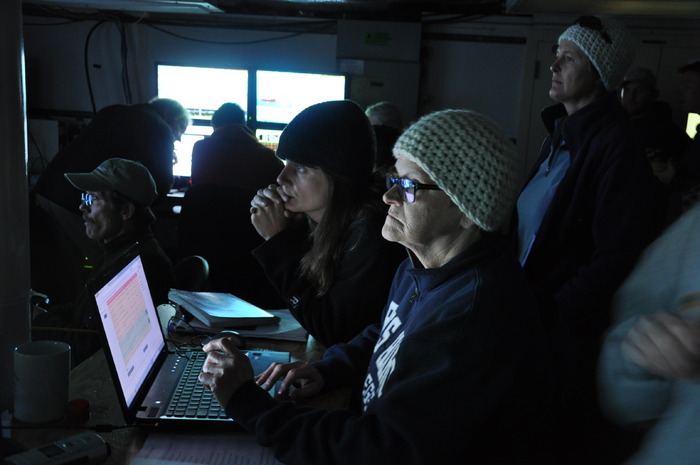
Wednesday July 3, 2013
7:14am
We passed through the Straits of Juan de Fuca last night and now are heading out along the continental shelf, toward axial seamount. Fortunately the swells are very gentle. No sea sickness yet. The boat is fairly quiet now before breakfast. Owen a graduate student in biological oceanography, was the only person working in the main lab. He and Brandon, an undergraduate oceanography student, study methane seeps and Owen was mathematically working out a way to determine the distance that a bubble is from the camera, given the size and the speed.
10:40pm
We reached axial seamount at 8:00 this evening as the sun descended into the clouds on the horizon. There has been a problem with the power draw on the primary node, likely due to an HD camera that was used for placement but is otherwise unnecessary. The goal of this cruise tonight is to solve the problem and the first plan of action is to remove the camera from the wet mount. A wet mount is essentially a power outlet that can be plugged into underwater. If that doesn’t solve the problem they may have to bring the node to the surface which could mean more than 24 hours of continuous operations.
This first dive this evening was a bounce dive. ROPOS, the submersible, is lowered to a depth sufficient to purge air bubbles from the lines. All of the science crew swarmed around the submersible as the engineers prepared for it to go in the water. Ben, the filmmaker, stood on the deck above the main desk, with his video camera. Alex from Nature also moved around the scene capturing shots to aid in her writing, and the students and scientists alike gathered in the few spots available where we could see, but were out of the way of the working crew. Jean( affectionately) called us the paparazzi.
I’m heading to bed now, but have added my name to the list of people who would like to be woken when the sub reaches the seafloor.

Tuesday July 2, 2013
9:10am
Although we departed this morning, the chief scientists requested that we spend the night on the boat to ensure that we set off smoothly in the morning.
My berth is windowless and it’s impossible to tell night from day without a timepiece. Breakfast was at 7:00am —a varied assortment of eggs, waffles, oatmeal, fruit, cereal, toast, coffee, juice, milk (rice, soy, dairy)...no shortage of choices.
We left the dock around 9:00 this morning. It’s now 10:44 and we’re passing through the Ballard locks. Skies are sunny and clear, the Olympics are slightly visible through the clouds. It’s a spectacular day in Seattle.
This 274 ft boat has four levels of decks. The aft deck – on the main level at the stern of the boat – is the staging area for the science operations. The Canadian Submersibles Group has two containers placed there as well as the remotely operated vehicle (ROV), many spools of cable, secondary nodes, a CTD, and the list goes on. At the main level there is a main lab with work spaces for everyone in the science party, an office, a control room for the ROV operations, a wet lab, and a very tiny gym. The ceilings in the gym are substandard in height and in order to accommodate tall people, they’ve removed one of the ceiling panels above the treadmill. Running on a treadmill while at sea with your head between ceiling panels seems like a hazardous activity, though I suppose some people venture to use it .
I’ve chatted with some of the people on board, and learning about the different parties involved in this expedition. Cecile, a project manager explained the parties involved to me this morning. NSF has selected UW to lead the Regional Scale Nodes (RSN) project, with John Delaney and Deborah Kelley as Chief Scientist and Co-Chief Scientist, respectively. The UW crew includes scientists from the School of Oceanography, engineers from the Applied Physics Lab, and graduate and undergraduate students.
The Canadian Submersibles Group ROPOS and L3 Maripro have been contracted to lay the cable and install the primary and secondary nodes which provide power and high bandwidth to the instruments. The list of instruments is long and impressive. To name just a few, there will be a mass spectrometer (nearly a mile below the sea surface!), a thermistor, a seismometer, high definition camera that will take images every second… and all of this data will be freely available to the public on the internet.
There are students and educators on board, too. Julie is a community college chemistry teacher form Aberdeen. She teaches the intro chemistry series and organic chemistry, and also a worked with a group of sixth graders from the local public school. She is also a grandmother and a quick knitter, who has already made two wool hats for people on board.
9:26pm
This afternoon everyone assembled in the main lab for a safety meeting. We all practiced putting on a personal flotation ( ‘gumby’) suit – a bright red neoprene suit in the unfortunate event that we need to evacuate the ship and end up in the water.
After dinner the science team (including engineers, marine techs, and students) met in the library for personal introductions and discussions with the lead scientists and engineers and the NSF project manager, Jean. ‘All the data, all the time, to all the people’ , she said. this is the motto that NSF is promoting for this project. The data will be streamed and immediately, publicly available once the sensors are laid and connected into the cable. On board are two videographers and a science writer from Nature, who make this adventure feel even more epic.


